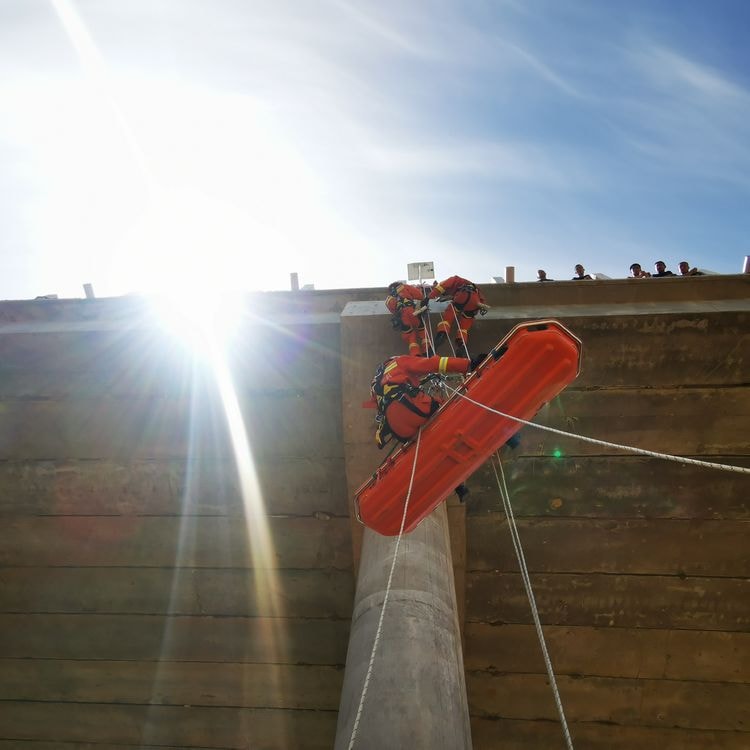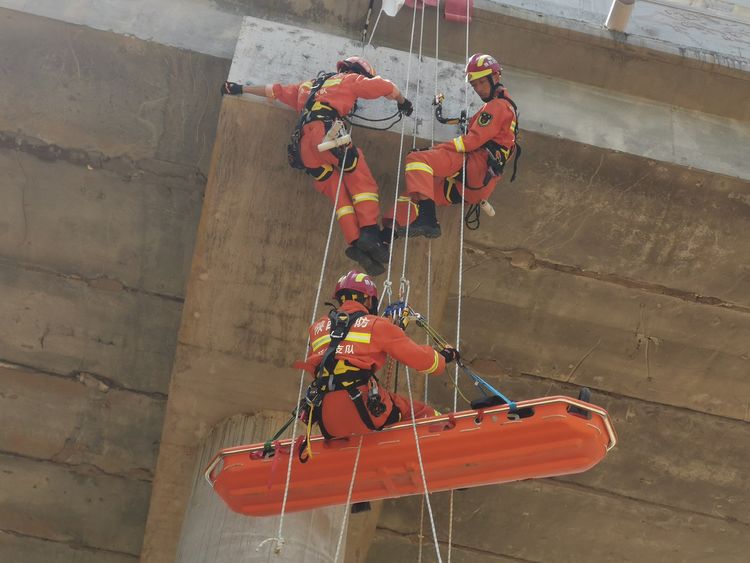A stretcher is essential for the safe transport of patients. Whether you’re in emergency services or healthcare, knowing which stretcher to use is critical. In this guide, you’ll learn about different types of stretchers, their uses, and how to choose the right one for various situations.
Key Takeaways
- Stretchers are essential tools for transporting patients safely in emergency situations, with various types tailored for specific medical needs.
- Different stretcher types such as ambulance, portable, and scoop stretchers are designed to cater to unique environments and patient conditions, highlighting the importance of selecting the right one for each situation.
- Regular maintenance and proper training in stretcher handling are critical to ensure functionality, safety, and efficiency in transporting patients. It is also important to ensure that all parts of the stretcher are fixed securely during maintenance.
Understanding Stretchers: Definition and Uses

A stretcher is a vital device used for transporting the sick, wounded, or even the deceased. Typically, it consists of a sturdy frame covered by canvas or similar materials, often measuring several feet in length to accommodate various body sizes. Also known as gurneys or trolleys, stretchers play an indispensable role in acute medical situations, primarily used by emergency services and military personnel. Their main purpose is to ensure the safe movement of patients from hazardous locations to other medical care facilities, thereby preventing further injury. This is particularly crucial in scenarios involving broken limbs, where mobility is severely compromised.
Stretchers are commonly seen in ambulances, hospitals, and even the funeral industry. Their design ensures that injured persons can be transported safely, minimizing additional trauma. Stretchers allow medical professionals to provide immediate care and stabilize patients during transit, underscoring their significance in emergency medicine.
Types of Emergency Stretchers Explained

Different types of stretchers are designed to meet specific medical and rescue needs. Knowledge of their unique features can greatly improve the efficiency and safety of patient transport. Here are some common types of stretchers:
- Ambulance stretchers, designed for fast movement
- Portable stretchers, which fit in confined spaces
- Scoop stretchers, used for patients with suspected spinal injuries
- Basket stretchers, ideal for rough terrain and rescue operations
- Stair stretchers, designed for transporting patients up and down stairs
Some stretchers have features that allow caregivers to raise the height or the position of the patient’s head, enhancing ergonomic benefits and ensuring patient safety.
Each type serves a distinct purpose.
Next, we examine the characteristics and uses of various stretchers, such as basket stretchers, spine boards, stair chair stretchers, and scoop stretchers.
Ambulance Stretchers
Ambulance stretchers are integral to emergency medical services, designed specifically for patient transport in ambulances. These stretchers often feature wheeled designs that allow for rapid movement, essential for quick patient transport during emergencies. Their lockable gas spring aids in easy loading and unloading, crucial in high-pressure scenarios. The ambulance stretcher is a vital component in ensuring patient safety and efficiency.
Ambulance stretchers often have features that allow caregivers to lower the height for easier patient access.
Apart from their mobility, ambulance stretchers are built to handle high loads, ensuring they can safely carry patients of varying sizes and weights. This high load capacity, combined with their wheeled design, makes them indispensable in emergency medicine, ensuring that patients reach medical facilities swiftly and safely.
Portable Stretchers
Portable stretchers are designed for flexibility and ease of use in various situations. Their lightweight and compact design is ideal for confined spaces like narrow hallways or crowded events. These stretchers can be quickly set up and easily transported by a single person, making them indispensable in emergency scenarios where time is of the essence.
Foldable stretchers, a type of portable folding stretcher, offer additional advantages in tight spaces. Their compact design allows for easy storage and quick deployment, which is crucial during mass casualty situations. The portability and flexibility of these stretchers make them a valuable tool for first responders and emergency personnel.
Basket Stretchers
Basket stretchers are essential for rescue operations in rugged terrains. Their rigid construction provides a secure method for transporting patients in challenging environments where traditional emergency stretchers and rescue stretchers may not be feasible.
These stretchers are specifically designed for vertical lifting and rough terrain rescues, ensuring patient safety during transport in difficult conditions.
Spine Boards
Spine boards are critical in emergency care for immobilizing patients with suspected spinal injury. These boards are designed to minimize spinal movement during transport, which is vital for preventing further damage in patients with spinal injuries. Stabilizing the patient’s spine, these boards help minimize the risk of additional trauma during transit.
Spine boards are especially crucial when spinal injuries are suspected. They provide a stable surface, ensuring that patients can be safely moved without exacerbating their injuries. This makes spine boards an indispensable tool in emergency medical services, providing essential support for patients with critical spinal injuries.
Stair Chair Stretchers
Stair chair stretchers are specifically designed to navigate stairs, allowing for safe patient transport in vertical situations. These stretchers facilitate the movement of patients in a seated position, making them ideal for narrow spaces such as stairways. Transporting patients down stairs safely is a major advantage in multi-story buildings and environments lacking elevator access.
Equipped with wheels and tracks, stair chair stretchers ensure smooth movement down stairs, enhancing safety during patient transport. This design feature is crucial for maintaining control and stability while moving patients in challenging vertical environments, making stair chair stretchers a valuable asset in emergency medical services.
Scoop Stretchers
Scoop stretchers are uniquely designed to transport patients with limb injuries without the need to roll them over. This design consists of two halves that come together beneath the patient, allowing for safe relocation without altering their position. This minimizes discomfort and reduces the risk of further injury during transport.
The split design of scoop stretchers enables caregivers to lift and transfer patients safely, ensuring that their position remains unchanged. This feature is particularly beneficial for patients with suspected fractures or limb injuries, providing a secure and comfortable method of transport.
How to Safely Use a Stretcher for Transporting

Safety is paramount when using a stretcher. Proper education in stretcher handling is essential to prevent equipment damage and ensure patient safety. Keeping the stretcher level during transport avoids tipping and patient discomfort. Assessing the patient’s weight helps in selecting a suitable stretcher that can safely support both the patient and any additional medical equipment.
It is important to ensure that all parts of the stretcher are fixed securely during use.
After loading the patient, securely locking the stretcher in place prevents movement during transport. During transfers, caregivers should firmly hold the handles until the stretcher is securely positioned. Such safety practices minimize risks and ensure the safe transport of patients.
Key Features to Look for in Modern Stretchers

Modern stretchers come with various advanced features designed to enhance patient safety and comfort. Durability and material considerations are crucial, ensuring that the stretcher can withstand different environmental conditions. Many modern stretchers include battery-powered hydraulics to assist in lifting and lowering patients, reducing the physical strain on caregivers. Many modern stretchers include features that allow caregivers to raise the height or the position of the patient’s head.
Additional features such as accessories for securing medical equipment and intravenous therapy during transport are also important. Compact and foldable designs make modern stretchers easier to store and maneuver in confined spaces.
Safety features like immobilization devices and secure straps are essential for trauma patients, ensuring they receive the necessary support during transport.
Choosing the Right Stretcher for Heavier Patients and Specific Situations

Selecting the right stretcher for specific situations is crucial for ensuring patient safety and efficient transport. Different forms of stretchers are designed for various scenarios, such as medical emergencies, transportation within healthcare facilities, and outdoor rescues. For confined spaces, portable, stair chair, and spine board stretchers are suitable options.
The type of injury also plays a significant role in choosing the appropriate stretcher. For instance, scoop stretchers are ideal for patients with limb injuries, while spine boards are essential for those with suspected spinal injuries.
Evaluating factors like weight capacity and the intended environment significantly enhances patient safety and comfort during transport.
Maintaining and Inspecting Stretchers
Regular maintenance and inspection of stretchers are essential to ensure their functionality and safety. Daily visual inspections can identify wear and ensure all components function effectively. It is important to ensure that all parts of the stretcher are fixed securely during maintenance. Inspecting the stretcher’s wheels and brakes before use prevents accidents during transport.
Monthly evaluations should assess the structural integrity of stretchers, checking for any metal fatigue or loose fasteners. Lubricating moving parts according to manufacturer guidelines prevents malfunctions.
Regular cleaning and disinfecting with hospital-grade products help maintain hygiene and prevent infections. Incorporating these maintenance protocols into standard operating procedures ensures consistent and effective upkeep of stretchers.
Importance of Training for Stretcher Handling
Proper training is crucial for the safe and effective use of stretchers. Proper training minimizes the risk of accidents during patient transfer by teaching correct usage techniques. Advanced safety mechanisms like locking wheels and adjustable straps are essential to prevent unintended movements during transport.
Proper handling of stretchers boosts confidence among medical personnel, ensuring safe and efficient patient transport.
CTA
Patient transport safety is not just about equipment selection—it’s about precise scenario matching and expert guidance. Whether you need help interpreting international stretcher standards, advice on selecting stretchers for extreme environments, or a complete list of ISO 13485-certified products, our rescue equipment specialists are here to provide tailored solutions. We rigorously select ambulance stretchers, scoop stretchers, and spine boards that meet CE/FDA standards, designed for hospital ERs, mountain rescues, and disaster scenes. Each device is tested for 160kg load capacity and -40°C cold resistance, ensuring reliability in critical conditions. Click to download our product catalog now, or contact our consultants for a customized selection report—equip yourself with professional-grade tools to save lives in every golden moment of rescue.
Frequently Asked Questions
What is the primary purpose of a stretcher?
The primary purpose of a stretcher is to safely transport the sick, wounded, or deceased to medical facilities or away from hazardous situations. This ensures the well-being of individuals during critical transitions.
Why are different types of stretchers important?
Different types of stretchers are crucial as they cater to specific medical and rescue requirements, ensuring both patient safety and efficient transport across diverse settings. The variety enhances the ability to respond effectively in emergencies.
How can the proper use of a stretcher enhance patient safety?
The proper use of a stretcher significantly enhances patient safety by preventing accidents and further injury through secure locking, weight assessment, and maintaining a level movement during transport. Implementing these practices is essential for ensuring a safe and stable experience for the patient.
Why is training important for using stretchers?
Training is crucial for ensuring medical personnel utilize stretchers correctly, which minimizes risks and enhances patient safety during transport. Proper training equips staff with the skills needed to handle various situations effectively.



